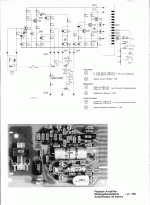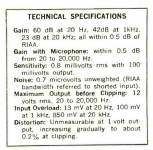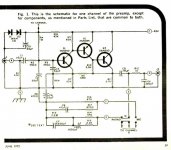I just checked, it was 'small signal audio design' Where DS analyses this. For those who don't have that the addendum to that chapter is here. Discrete design: 2-transistor RIAA preamp . I still think its fascinating how readily performance can be very significantly improved, even if a 50p op-amp will still outperform it 
Derfy, the issue is basic (not the same a simple.)
C = q/V. C dv/dt + V dc/dt = i. In the series parallel combination each equal value capacitor has the same value so V = 1/2 and dc (a function) will have a different value than a solo C. If dc has half the value the each capacitor in the four pack will produce distortion of 1/2 x 1/2 or 1/4 of a solo unit at full voltage. Thus the two in series of the four pack will produce 1/2 the distortion. Now when you parallel two of the series twofers to make the four pack the combined distortion does not increase, however any internal issues that can be treated as noise will drop by the square root of 2.
As you have two sides of the bridge that will double the distortion difference from the 1/2 that each 4-1 pair (side) will produce. So you end up able to see the distortion clearly.
Note what also falls out is that the C dv/dt component should cancel to the limit of the 4C-1C match. Note the even if dv is a series of sines (AKA distortion) they should also cancel. Thus you can measure passive component distortion below the test generator normal limits.
Now that I believe is as simple as I can make it. Even so almost no one gets it. Typical errors are to use a reference part instead of the Gang of Four. Thus calibration is lost. By shuffling around parts in where they are in the gang of ten you can tweak in on each unit part's contribution.
The technique does require very similar parts.
Thanks for the description. Definitely understand what you're trying to achieve, but there's just some details I'm not perfectly getting (that's on me). I just need to sit down and hash out why this is/isn't more sensitive test (or same) than the description Samuel gives in his thesis, which is to flip/flop in the 2s/2p for a single DUT in a simpler RC. Cheers!
Last edited:
The 2-3 transistor circuitry - polar cap coupled - was the norm. The revered Revox A77 Pro recorder, shows what we were dealing with circuit-wise. Everything is better today.... opamps, and discrete.... VFB or CFB.
View attachment 671176
THx-RNMarsh
The A77 wasn't a pro recorder, but the pro ones probably was not better eider. On the other hand they filled the purpose ,recorded all kind of beautiful music for our enjoyment and we still listening to them. That shows our high threshold of sensitivity to distortion.
The A77 wasn't a pro recorder, but the pro ones probably was not better eider. On the other hand they filled the purpose ,recorded all kind of beautiful music for our enjoyment and we still listening to them. That shows our high threshold of sensitivity to distortion.
depends.... my 1/2 track 15/30 ips A77 would be in the Pro catagory. Electronics the same.
The sound was a lot better from my own recordings than what i was hearing thru my TT/LP system.
usually, I have no issues with technical talk here but as soon as I say i heard this or that, all hell breaks loose. But, I use both listening and measurements and accept both as valid to within certain limits.
THx-RNMarsh
Last edited:
Hi Richard,
Having worked on many of those, yes. They could sound pretty good. Still, I would prefer a B-77 in the same configuration. The A-700 was nicer and they all used the same heads. I think the attraction to the A-77 must be mostly romantic, or it could be that sound they had.
-Chris
Having worked on many of those, yes. They could sound pretty good. Still, I would prefer a B-77 in the same configuration. The A-700 was nicer and they all used the same heads. I think the attraction to the A-77 must be mostly romantic, or it could be that sound they had.
-Chris
Hi Richard,
Having worked on many of those, yes. They could sound pretty good. Still, I would prefer a B-77 in the same configuration. The A-700 was nicer and they all used the same heads. I think the attraction to the A-77 must be mostly romantic, or it could be that sound they had.
-Chris
Of course there were several others that are better - maybe even great but I didnt own any of them. I did have a nice 8 channel Otari MX-8080. used the high speed A77 for mix down to 2 channel master.
Just saying this is the topology popular at the time in preamps and recorders and tuners (audio section) etc. The A77 used 8 polar caps per channel on just the playback side. The polars were a lot worse than polars are today, but still. This is what got me to thinking how to be rid of all those caps via topology change. No one has looked back since..... But then we see the Sony FM HD tuner is back to the junk designs for the audio portion, again.
Though we have found better parts and topologies since then... big high volume companies keep doing this sort of thing so i guess it will keep the debates going for centuries.
We have 'fixed' many of the big problems in circuit design for audio and are left with fine tuning them. Except we havent got to fixing the speakers yet. I had lunch today with Keith Yates (Keith Yatees Design - acoustician-architect) and he agreed 100% from his studies of speakers and rooms and designing hundreds of high-end rooms for audio and A-V --- about the low dynamic range and wide polar patterns lingering for decades. Other than Myer Sound Labs and JBL (M2) he could not think of a #3 speaker to use that comes close to what is needed.
THx-RNMarsh
Last edited:
depends.... my 1/2 track 15/30 ips A77 would be in the Pro catagory. Electronics the same.
The sound was a lot better from my own recordings than what i was hearing thru my TT/LP system.
usually, I have no issues with technical talk here but as soon as I say i heard this or that, all hell breaks loose. But, I use both listening and measurements and accept both as valid to within certain limits.
THx-RNMarsh
On that speed a live recording would be out of this world. I never seen one 30 ips one. What I found irritating with the Revox A77 (if I remember correctly) is the fact it didn't had a Pause function. In case of recording you couldn't put it to Stand By. I made some live recordings in the eighties (nothing serious , just for fun) with a Sony WM-D6 and an amateur copy of a Sennheiser kunstkopf with electret mics, the best stereo I ever heard.
Miklos
I was getting on the plane in Chicago at 5PM and downloaded this thread to catch up, now I have less to catch up on. More time to prepare some stuff for Ed.
I was curious whether our departed friend would find time to say anything interesting or at least about DIY, but then he wasn't lashing out at me.
On that speed a live recording would be out of this world. I never seen one 30 ips one. What I found irritating with the Revox A77 (if I remember correctly) is the fact it didn't had a Pause function. In case of recording you couldn't put it to Stand By. I made some live recordings in the eighties (nothing serious , just for fun) with a Sony WM-D6 and an amateur copy of a Sennheiser kunstkopf with electret mics, the best stereo I ever heard.
Miklos
That is my experience also. Way better than LP. Until recently, it was the standard to use as source. But, we have HD direct down-loads now. very nice.... too bad it took so long to get back to the future in high quality sound.
Thx=RNMarsh
You should try a couple of Hirata waveforms, DPH. You can READ the engineering note, can't you? It should be easy for you to digest.
I think that it is appropriate to put in one of the Hirata papers also, so people can see different waveforms that are hard to produce with just sine waves, and are asymmetrical in character. The Hirata test is one of the most interesting that I have ever found that is usually unknown to typical engineers. I have tried it, and it works!
the paper
In the subject of Hirata distortion, here is another paper by Hirata.
PMA, I agree with you that most 'reasonably engineered' amplifiers might not show much with the Hirata test, BUT I have measured one glaring problem with one of my early op amp prototypes, when I added an AC balance pot. I was hoping to discuss it in detail, once people got the Hirata test in their perception.
What is most important is that the Hirata test CAN show problems not shown by Harmonic or IM tests. It is not the only test to show something not seen with thd, etc tests, but it is available in print, so I put it up as an example of WHY thd or IM (no matter how many tones) is not necessarily enough. Back in the early 80's I had access to even more material by Dr. Hirata, including measurements of some common commercial amps at the time. This was a more detailed, and revealing of even some DC coupled amps, as well as Dolby, etc.
I don't expect anybody, including myself, to completely understand Dr. Hirata's papers, but it concludes accurately.
Now that would be interesting, to see how the Hirata test revealed a problem (audible or not as RNM said), that other tests/measurements did not reveal, what you changed to fix it, and test results on the revised amplifier.
As Jan said, it's not very interesting to put up an old paper without relating it to actual design decisions. I would find it far more interesting to see how Hirata test results would drive design changes.
So did I miss something? I am still wating for JC to actually say something about the Hirata test and how it helped him detect and fix a flaw in an amplifier, and why no other test would have revealed that flaw. I am not a professional nor even a competent amateur, but I am curious ro see how Hirata's paper actually informed product design and how it was more revealing than more conventional tests.
Hi Richard,
I agree with you on that. How did you get around the channel swap that the A-77 does? I guess knowing about it is most of the problem solved.
Hi Miklos,
30 ips with tape has issues. The head bumps that were in the bass region now show up in a more audible range. Studer EQ'd them out, but that is expensive. I wouldn't recommend going to 30 ips for 2 dB of s/n improvement. At 15 ips you're already up in the 22 ~27 KHz range for top end response (on a Teac too). That's got to be enough top end for anyone.
A 15 ips half track sounds glorious. I just sold my BR-20 to a friend. Just wait until he hears what this can do!
-Chris
I agree with you on that. How did you get around the channel swap that the A-77 does? I guess knowing about it is most of the problem solved.
Hi Miklos,
30 ips with tape has issues. The head bumps that were in the bass region now show up in a more audible range. Studer EQ'd them out, but that is expensive. I wouldn't recommend going to 30 ips for 2 dB of s/n improvement. At 15 ips you're already up in the 22 ~27 KHz range for top end response (on a Teac too). That's got to be enough top end for anyone.
A 15 ips half track sounds glorious. I just sold my BR-20 to a friend. Just wait until he hears what this can do!
-Chris
When it comes to analog tape recorders, I have a lot of experience. 50 years ago, I bought a semi-pro Ampex tape recorder called an AG-500. It had a pretty good transport, 15ips, 1/2 tr. and the typical 3 transistor circuits with a single supply, like what was described here earlier. It had a number of small problems at first, but I worked it over, without actually changing the topology much, and made it into a better tape recorder than most were at the time (early 70's). The GD recording engineers thought so as well, certainly better than the AG440 electronics used also in the Ampex MM1000. Actually, BIASED Tantalum caps are not as bad as UN-BIASED Tantalum or Aluminum caps. They do have some DA, but when biased, less than Aluminum caps and the low frequency distortion drops to almost nothing. In 1974, I started working with the electronics of the STUDER A80, and the first model that I had was sort of OK, but they changed to a second model that had typical IC's in the audio path with a Class C output. This sucked! I made some measurements, took photos of the distortion in the line stage, and personally showed Willi Studer and his engineers what I found. Did they fix it? No. So, 4 years later, in 1979, I threw away the analog electronics of a brand new A80, and designed new electronics. This was for Mobile Fidelity. I did another unit, as well with a preview head for the same company. The company tried to take the design away from me, so they could make it independently themselves, but they did not have access to the schematics, so we had one big battle, almost winding up in court, and I dropped making another tape machine for awhile. But in 1983 Dave Wilson commissioned me to do another Studer, and that unit is still being used today. It is considered one of the best analog tape machines in the world today, still. However I had to triple the bias frequency, and more than double the track width (full tr. 1/2"), EQing to 10 Hz at 30 ips to get it right. It was expensive and time consuming to make the electronics for these analog recorders, but I did appreciate the STUDER tape transports, the are VERY NICE. Those Swiss are great with mechanical stuff.
Now why do I appreciate the Revox A77 electronics? It is very similar to my Ampex AG-500, and I know how it can be made to sound very good, better than most analog transports. As proof, Dave Wilson used a 15ips 1/2tr A77 for several master recordings that he put out on vinyl, before my machine was ready. They sound pretty darn good too!
Now Studer, you might think would learn about electronics, and improve them, but they didn't, so far as I can determine. The earliest electronics, whether tube or transistor were better.
Now why do I appreciate the Revox A77 electronics? It is very similar to my Ampex AG-500, and I know how it can be made to sound very good, better than most analog transports. As proof, Dave Wilson used a 15ips 1/2tr A77 for several master recordings that he put out on vinyl, before my machine was ready. They sound pretty darn good too!
Now Studer, you might think would learn about electronics, and improve them, but they didn't, so far as I can determine. The earliest electronics, whether tube or transistor were better.
- Status
- Not open for further replies.
- Home
- Member Areas
- The Lounge
- John Curl's Blowtorch preamplifier part III


